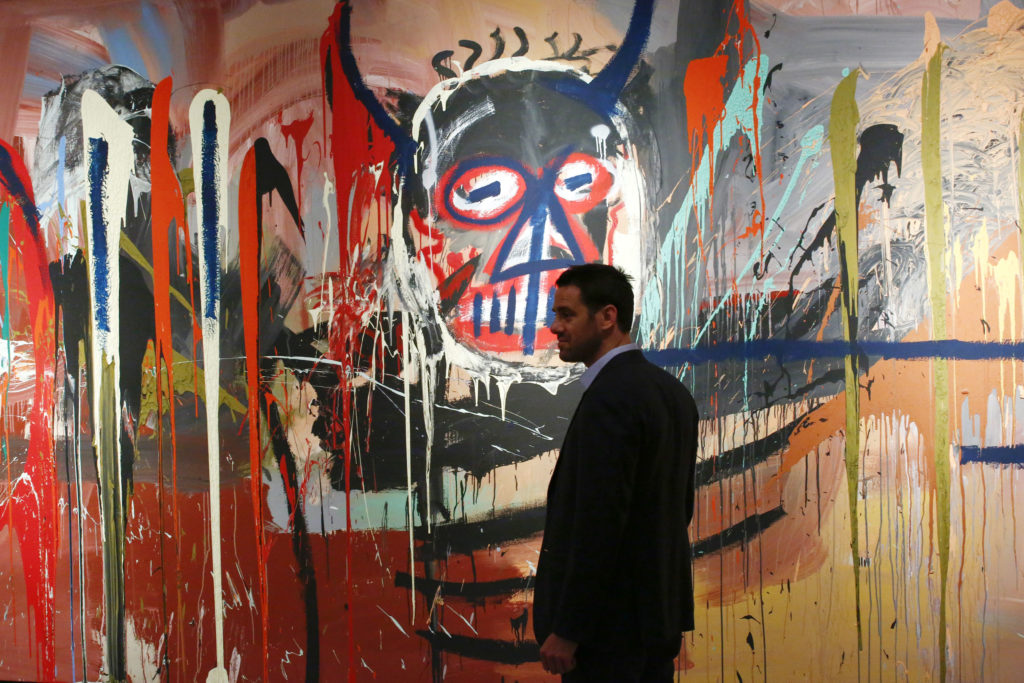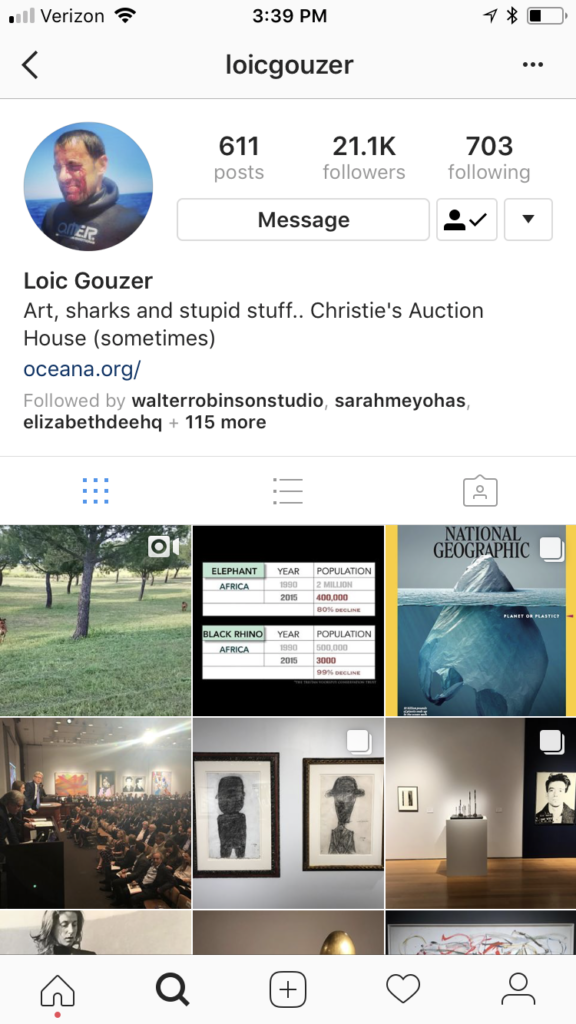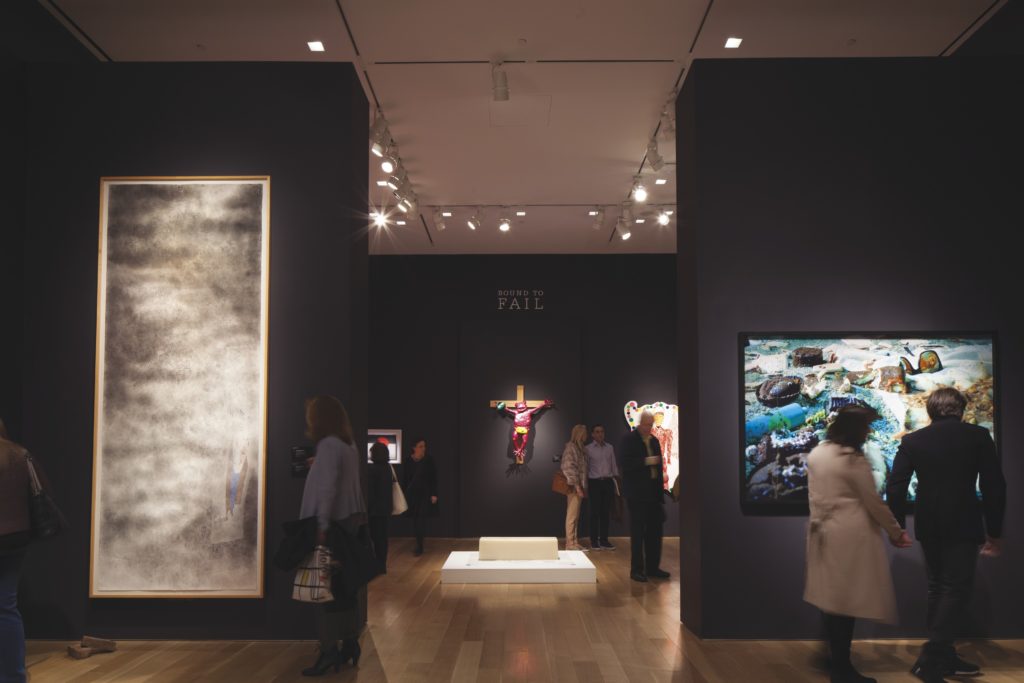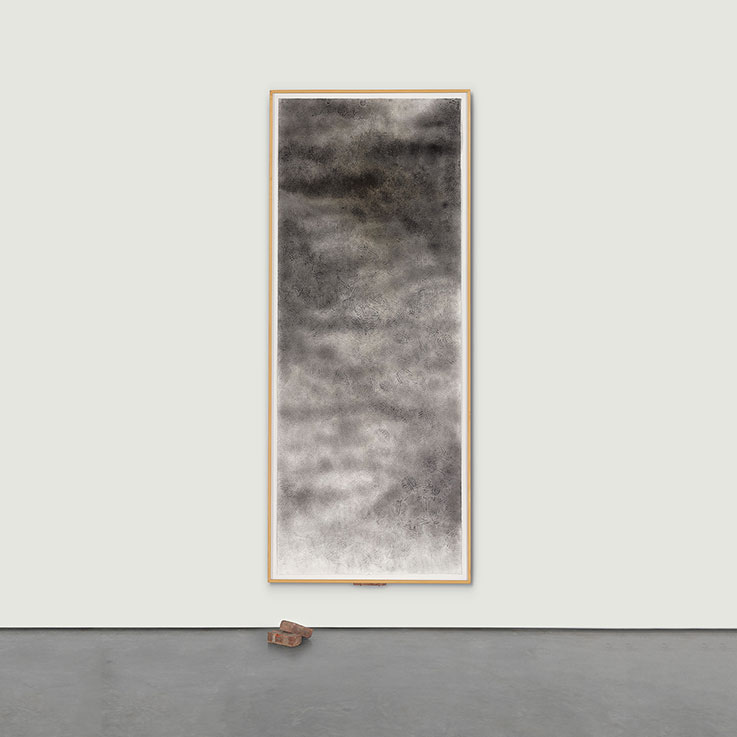People
‘The Whole Way of Collecting Has Changed’: Christie’s Loïc Gouzer on the Regrettable Rise of the ADD Art Collector
artnet News's Andrew Goldstein spoke to the auction-house rainmaker about why no one wants to learn about art anymore.

artnet News's Andrew Goldstein spoke to the auction-house rainmaker about why no one wants to learn about art anymore.

Andrew Goldstein

When it comes to innovation in the field of art auctions, it’s true that the Christie’s rainmaker Loïc Gouzer is hardly alone. That august auction house, in fact, has an impressive track record of minting dynamos from Amy Cappellazzo (who left to found Art Agency Partners, now part of Sotheby’s) to Philippe Ségalot and Brett Gorvy, both of whom now sell art privately. But Gouzer certainly takes home the distinction, if one can call it that, of being the oddest fit among those ranks. An antsy character with a half-heartedly decorated office, he often gives the impression that he’d rather be doing something other than the workaday labor of powering the world’s number-one auction house—perhaps directing a movie, or playing soccer, or raising money to save the whales.
It so happens, with his record of bringing in eye-popping business, that Christie’s seems to encourage these flights of fancy—with the calculated bet that even a failure or a bout of spearfishing (like the episode that lead to his bloodied Instagram portrait) might lead, like the Prince of Serendip, to untold success. It’s nice work if you can get it, but some people already wonder how much longer the arrangement can last, including Gouzer himself. In the meantime, at least, he seems to be enjoying himself mightily.
For the second half of a two-part interview, artnet News’s Andrew Goldstein spoke to Gouzer about his renowned fondness for using Instagram as a selling tool, his feelings on China’s growing weight in the art market, and why collecting art makes you a better businessman.
We spoke earlier about how you’ve used unconventional means to shake up the age-old auction business. One tool you’ve used to great effect has been Instagram, where you post a mix of blue-chip artworks from your upcoming sales, wildlife-conservation statistics, and photos from your personal life. You’ve built an engaged audience of 21,100 followers—as of this week—that includes such famous “like”ers as Gisele Bundchen. You’ve also used it to engage in entertaining flame wars, such as when you posted a spoof of fake Wade Guyton laser-prints saying “Thank U” after that artist creatively objected to being included in your “If I Live I’ll See You Tuesday…” sale. How do you feel Instagram is best suited to move the art market along?
Instagram is an incredible tool because you have direct access to collectors. I would estimate that at least 80 percent of the collectors I deal with follow us on Instagram at Christie’s, so we can use it undercut the traditional press, which is a good thing. Sometimes I also use it as a calling card when I’m putting together an auction in order to attract works: “Hey, guys, I’m doing a sale—this is what I’m looking for.”
You and your former boss at Christie’s, Brett Gorvy, are two of the most adept users of Instagram in the art market. He has used his account to sell multimillion-dollar Basquiats and you’ve used it to build up anticipation for your sales. Who learned how to use it from whom?
I’ve actually sold a lot of works through Instagram too—I just don’t advertise it when I sell them, while Brett makes a point of letting everyone know that he sold work. Instagram definitely works for selling art. But to spend a moment on Brett, just because I want to mess with him, he’s a bit—to put it politely—neurotic, like we all are in the art world. I told him, “You should go on Instagram—it would be a good outlet for your neurosis.” But I didn’t know he’d be so crazy as to make a religion out of it. He posts a lot, to the point where it became impossible to even speak to him when we were working together, even though we were one office apart. One day, I had to put a post on my Instagram: “Brett, please call me.” He called me instantly.
That’s very funny.
At the same time, while I work for Christie’s, Instagram is my private realm, so it’s this gray zone that allows you to do certain things. I remember there was this ad that I wanted to do for “If I Live I’ll See You Tuesday…” when I put the two Koons basketballs that were in the sale into one image and said, “It takes Koons to collect contemporary art.” But although Koons approved it, management didn’t like it. So I said to hell with it and just posted it. It was great, because it was not approved by Christie’s, but it was approved by Loïc, and that’s all I need on Instagram.
Normally I’ve heard that if you do Instagram you should always be consistent and post about the same thing. In my case, I’m pretty schizophrenic—I jump from showing artworks to showing dead sharks and talking about conservation. And it works. Suddenly, when I sit down at board meetings of [the ocean conservation nonprofit] Oceana and look at who recently gave donations, I see random names that follow me on Instagram. I really like this cross-pollination between art collectors and the environment.

Gouzer’s instagram. Screengrab by Andrew Goldstein.
You said you’ve sold artworks through Instagram. Is it easy to attribute which artworks were sold because you posted them, or is it fuzzier than that?
I’ve actually sold quite a few artworks on Instagram, and I’ve also done some private sales for Instagram. A lot of times it’s clear because after I’ve posted something I get a phone call from someone saying, “Hey, I saw this on Instagram—I want to bid on it.” Now, the tricky thing is that there are a lot of collectors who sometimes contractually require that we post the work they’ve consigned on our Instagrams. I don’t want to do it, and I don’t really accept it. I want to be free, posting what I want. But more and more we have collectors requiring that, if they give their work, we have to post it on Instagram, or on WeChat. Most Chinese collectors live and breathe WeChat, and buy art they see on WeChat. I don’t use WeChat, but I really should.
Another mode of technology that you’ve been using to promote your sales in a novel way is viral videos. First there was the skateboarding video for “If I Live I’ll See You Tuesday….” that created a lot of buzz, and then you had the other recent video for Salvator Mundi that showed all these teary-eyed art pilgrims looking at the painting, apparently in the grips of Stendhal syndrome. What was the idea with that first video, with the skateboarder? It was certainly a change of pace for an auction house like Christie’s.
Traditionally, auction-house videos have been specialists talking in front of the art, so I thought we could do something different. The skateboarding was a bit of schtick, and a bit of adolescent fantasy. I have a lot of respect for art, but I also think things should not be taken too seriously, because that’s when you lose perspective. Christie’s is such an institution, and I’m not saying it’s a cult, but it’s good to sometimes desacralize the institution for a minute. I wanted to show the whole machinery behind the scenes, where it’s like an iceberg in that 10 percent is exposed and then 90 percent—the hard-working people—is submerged. I thought skateboarding through the back rooms would show people that it’s not the Wizard of Oz. Unfortunately, I didn’t know how to skateboard, so I had to hire someone.
It’s funny, I once wanted to do another video for “Looking Forward to the Past,” and I had this crazy idea that was so complicated I’m not even sure I completely understood it myself. I hired a movie director and I created a giant studio and had all the work floating in the air. We tried to do something that was impossible, and then failed. We could have done it, but it demanded such a huge amount of money for so many special effects that we decided to kill it. That’s my one big regret at Christie’s.
Since you began your auction career a decade ago, joining Sotheby’s in 2007, the audience for auctions has changed. Instead of being populated by the David Rockefellers of the world, now there’s a new generation of cool young collectors like the Japanese billionaire Yusaku Maezawa—who announced his purchase of the $110.5 million Basquiat via an Instagram post—who are completely plugged into the tech world and pop culture. How have you seen the makeup of the collectors you deal with shift over time?
Collectors have changed quite a lot in the 10 years I’ve been doing this job. When I started, you would sit down with a collector, they would ask questions, you would show them the work, you would show them the catalogue raisonné, you would explain how this work fits into the oeuvre—you’d have a whole discussion to help form a judgment. Now people’s attention spans have become far shorter, and not only in art but in every way. These days, people come in and you’ll say, “Here’s a Twombly painting—you should compare it to others in Twombly’s catalogue raisonné,” and they’ll say, “I just need to know if it’s an A or an A+ or B+.”
You have people who can literally pull the trigger on a $20 million or $30 million painting just by seeing an image on Instagram, and without asking further questions. It’s interesting, socially, but sometimes I get a bit depressed about it. It’s sad that maybe only eight percent of the collectors today actually enjoy discussing art and asking questions. In a way, as specialists, we have so much to give. We have learned so much over the years. But now a lot of people don’t really care. I guess it’s the way people make their decisions.
I think the whole way of collecting has changed, quite a lot. But I have a bit of nostalgia for those days, not so long ago, where every time you would sell a painting it was a whole conversation.
Another aspect of the art world that has changed tremendously is the growth of the importance of China, and Asia more generally. You’ve been involved with the Chinese art scene for longer than most people in the West. What first brought you to China, and where do you see the relationship between China and the Western art market evolving?
I remember being at school when I was 16 and hearing in geography class that China would be the next superpower. When I later started working at a small gallery called Analix Forever in Geneva, I had this idea that if China was becoming a superpower, there must be artists out there. I asked another dealer, Pierre Huber, for just one artist’s name and phone number, and I did a deal with Analix Forever that if they would finance part of my trip to China, I would come back and do a show of Chinese art in exchange.
So I went there knowing nothing, but I met all the guys that became famous, like Yue Minjun, Zhang Xiaogang, Ai Weiwei. This was around 1999, and I was just 19 or 20, and it was incredible because no one cared. And those guys were pretty much semi-hiding, because what they were doing was barely tolerated. There were very, very few people collecting their work, so I basically used my bar mitzvah money to buy what I could.
Later, when I started at Sotheby’s, I think I was so annoying with the Chinese stuff that they said, “Just do it so we don’t have to hear about you anymore.” I put 10 Chinese works in a sale, and it went crazy—all the lots sold for something like five times the estimate. And that was perhaps day one of the Chinese contemporary art market.
China is definitely a huge player now. The speed at which they learn, their curiosity, and their eagerness to know about everything is incredible. Traditionally, you would say to the collector, “Start buying Renoir first, or Chagall,” and then it would take him 50 years to get to buying a Robert Ryman. The Chinese maybe buy a Renoir first as an entry point to the art market, and in six months they’re already buying their first Ryman or Bruce Nauman.
What you’re seeing is that art is becoming similar to a global currency, where people of different cultures have something in common. If you’re in Shenzhen and you buy an Andy Warhol, then suddenly you’re part of a giant international circuit of discussion.
I would say it’s like a rich man’s version of football [translation: soccer]. When I’d travel when I was young, I would always bring a football with me because in most countries we couldn’t communicate with people, but if you take a football along then suddenly there’s a whole match going on in the middle of the Mongolian steppe. In the same way, art has become an incredible communication tool in a world where everything seems to happen online, on WeChat or Instagram or Twitter. There, art is something as tangible as a football.

Gouzer’s 2016 “Bound to Fail” auction at Christie’s brought in $78 million. Photo courtesy of Christie’s.
Another sport I’ve always thought it resembles is golf, because golf is something that businessmen can do together or talk about when they aren’t doing business—which only allows them to do more business. So now the art fair has become the new golf course.
Yes. And it’s really a mind exercise, too—some people do Sudoku, some people do crosswords, and some people collect art. It’s really something that opens your mind. The other day I was having lunch with [Christie’s owner] François Pinault in New York and someone asked him how important it was for him to collect. He answered, “I think if I hadn’t started collecting, I would still be selling wood in Brittany.” It opened his mind to everything, because it forces you to keep the part of your brain that handles curiosity active. Collecting art is incredible mind gymnastics, basically, because it means always pushing yourself further. Which raises an interesting point: most collectors we deal with are incredible autodidacts. I know very few collectors who have actually been educated at Harvard or Yale—most of the time, art collectors are self-made men or women, school dropouts who created empires and were extremely successful. And the one common denominator is their curiosity. The know-it-all people usually don’t collect art, because they know it all.
One thing that’s so intellectually stimulating about art is that the field is constantly changing. In this past auction week, for instance, we saw tremendous records set for work by black artists, and recently women artists have really been coming to the fore in a new way. What do you make of these new developments within the market that suggest a possible shift away from the old, white, European, male artists to a different paradigm?
I think it’s very positive when people look at art for the art—for what it is, rather than who made it. I think right now there may be knee-jerk reaction to the way things were before that is going all the way over to the other end, and that we’re seeing this with the revival of interest in black artists. But I think all this is going to balance out. But while I believe we all are somehow subconsciously biased, I fundamentally believe that I’ve never looked at art through the prism of gender or race. I’m sure a lot of people have done it, most likely subconsciously. But I think it’s very healthy for people to look at art for what it is. For example, my favorite living artist is David Hammons. He could be whatever he wants to be—I don’t care. I think he’s the Brancusi of our time.
I also come from a very liberal, no-judgment background, with my mother being perhaps the first female lawyer who actually made it in Switzerland at a time when it was impossible for women to do anything. So I don’t think I have any bias in my DNA whatsoever. It’s something I have trouble even grasping.

David Hammons’s Throwing Up a Brick (1998) sold for $1.4 million in Gouzer’s “Bound to Fail” auction. Photo courtesy of Christie’s.
So, while artists rise and fall, and trends come in and out of fashion, the art market in general has had a heady upward trajectory ever since you started in this business, with barely a dip during the financial crisis and then pure hockey-stick growth. What would you say is your outlook for the art economy over the short term, and then over the longer term of the next 10 years?
People are always worrying that the art market must be a bubble. But actually that’s a misinterpretation. The art market has been strong, but it’s not booming. The reason why it always looks so strong—with huge prices and all that—is because auction houses tend to focus on the artists that are doing well at a specific time, because those are the works that transact. All the artists that are not performing well? These are the ones that we don’t talk about. So, number one, I think the art market is pretty healthy. But it’s not a bubble.
What is not very healthy, however, is the fact that—as is the case everywhere—the power of brands is becoming overwhelming. So people buy from galleries and auction houses as if they were Hermès or Gucci or Tom Ford. I think there are a lot of great artists who are not in the limelight, and a lot of smaller galleries that struggle to sell some very good artists. So the auction house has a responsibility to not just focus on the same 200 artists but to try to experiment and bring a lot of unsung heroes to the market.
But as for collecting, it’s almost a genetic, subconscious urge, and it’s not going to go away—it’s only spreading. Every season we have a new influx of collectors from Asia, from Silicon Valley. I see a lot of growth there, because there’s still only a fraction of the people who can afford to who buy art. Just imagine, I think Leo Castelli’s entire mailing list was 150 or 200 people, and they were a major gallery. Now galleries have mailing lists of tens of thousands of people.
So even if there are downturns—which there will be—the growing pool of collectors is going to keep the market going strong. I went through the market crisis, but it was interesting that while people stopped buying for a while after Lehman Brothers [collapsed], it was almost like those mushrooms that don’t pop up some seasons but still continue to grow underground. When the crisis was over, all those mushrooms—all those new clients—came out from everywhere.
You spoke about wanting to promote the “unsung heroes” of the art world. Would you ever want to go into the gallery business, like Brett Gorvy, and work directly with artists?
I always have trouble thinking more than six months ahead. I love art, but if I look at the long term I feel that we all have a responsibility to protect our planet. I just have a very hard time going to work and selling art while I know what’s going on in the oceans and the forests. I know that we are going to be the generation that will be pointed at by our children, saying, “Why did you not do anything?” I don’t want to go too far, but my parents’ generation was pointing at their elders, saying, “Why did you not do anything when the Holocaust was happening—you were complicit, because no one did anything.” I think we’re going to receive the same judgment from our kids. So I don’t want to be the guy whose reply is, “Yes, I knew that it was going on, but I didn’t realize how bad it was.” I want to be the guy who says, “Look, I did everything I had in my power to stop the ecocide of the planet.” So I don’t know when, but I know that down the line I want to focus much more on that. Art won’t be as interesting once the museums are submerged underwater.